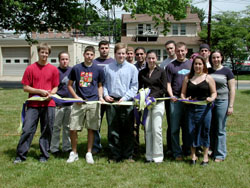 |
| Participating in the ground-breaking for the solar house are, front row, Scott Kasprzak, Jason Book, Tom Shipman, Lauren Leonard, Dominic Pellegrino and Katherine Piazza, and, second row, Gwen Thorson, Tony Nasr, Sean Custorani, Don Kerr, Anthony DiStasio and Liz Cantoni. |
The University of Delaware’s Solar Decathlon team held a ground-breaking ceremony Thursday, May 16, at 115 Delaware Ave., on the University campus in Newark. The ceremony launched the on-site construction phase of the 800-square-foot house that will be entered in a national competition sponsored by the U.S. Department of Energy this fall.
Fourteen universities nationwide have designed and are building fully self-sufficient solar houses that will be displayed in a “solar village” on the National Mall in Washington, D.C., from late September through mid-October.
Student teams are responsible for every aspect of the competition of 10 events, including lighting, refrigeration, comfort, and design and livability. During the event, only the solar energy available within the perimeter of each house may be used to generate the power needed to compete in the contests.
According to Lian-Ping Wang, associate professor of mechanical engineering and UD project leader, the objective of the competition is to demonstrate new technologies to an energy-conscious nation.
Eric Kaler, dean of the College of Engineering, said it was appropriate the solar house ceremony was being held on a bright, sunny day. He added he hopes the project will remind the community of “the wisdom of using green energy sources.”
The project, Kaler said, demonstrates “the University’s commitment to excellence in undergraduate education.”
A special guest for the ceremony was Karl W. Boer, Distinguished Professor Emeritus of Physics and Solar Energy and a pioneer in the field of solar power. He noted that is was 30 years ago when he became the founding director of the University’s Institute for Energy Conversion, which oversaw the construction of UD’s first solar house on South Chapel Street.
“Many new ideas have been incorporated here,” Boer said. “I hope they will be recognized worldwide, and during the event in Washington, D.C., and I hope you come out a winner in the competition. My very best wishes for a successful result in this very important enterprise.”
After the house is erected on the UD campus, it will be dismantled for transport to the contest. Following the Decathlon, it will be displayed for a short time at the Franklin Institute in Philadelphia and then returned to the Newark campus, where it will serve as a long-term display and living laboratory.
According to Ajay Prasad, associate professor of mechanical engineering and faculty adviser in the area of mechanical and electrical systems, the technologies being used in the house are not new in themselves—the novelty lies in their integration into a single house.
According to Prasad, the team has sometimes had to be quite creative in interpreting the competition rules. For example, they wanted to use a tank of water to simulate a geothermal reservoir for heating and cooling with a heat pump, but the contest rules dictated that only two tanks be permitted on each lot–one for freshwater and one for wastewater.
A careful reading of the rules, however, showed that a minimum size was specified for the wastewater tank, but there was no maximum. So Prasad worked with student technical leader Thomas Shipman to design a large divided tank, with one half dedicated to the geothermal function and the other half for wastewater.
Wang said that while the team has raised an amount equal to what they initially thought the house would cost, they have learned some lessons along the way about estimates and reality. “We’ve really pushed the envelope on materials to take advantage of the best technology available,” he said. “For example, we’re using heat mirror windows because of their energy efficiency. Things have ended up being more expensive than we expected. Also, we would like to have additional funds to support 15 undergraduate and vocational school students this summer for the construction and testing phases of the project.”
According to James Glancey, associate professor of bioresource engineering and faculty adviser on this final phase, a construction kick-off organized by student leader Lauren Leonard resulted in an impressive turnout of students. Many of these students will continue their involvement during the summer as Solar Decathlon fellows or interns. The anticipated hands-on participation has attracted a fresh surge of talented students and leadership.
Wang said he is justifiably proud of the tremendous fund-raising effort undertaken to date. “We’ve raised about $142,500 so far in cash and in-kind donations, not to mention the expert help we’ve received from many of our sponsors,” he said. “But we still need help. I would really encourage companies and alumni to support the project in any way they can, and I especially would like to invite everyone to come to campus this summer to see the work in progress.”
To date, major sponsors for the project include AstroPower, Sustainable Development Fund, Eco-Thermal Panel Systems, Hardcore Composites, DuPont and Traco.
Potential donors should contact Susan Coombes, departmental manager of operations, at coombes@me.udel.edu, or Wang at lwang@me.udel.edu.
Photo by Kathy Flickinger
May 16, 2002
|

